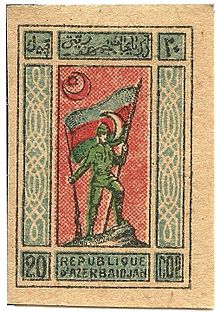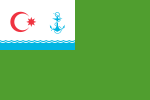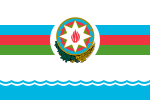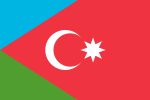Flag of Azerbaijan
| Flag of Azerbaijan | |
|---|---|
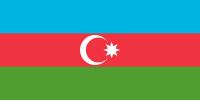 |
|
| Vexillological symbol : |
|
| Aspect ratio: | 1: 2 |
| Officially accepted: | February 5, 1990 ( Republic of Azerbaijan ) |
The flag of Azerbaijan was introduced on February 5, 1990 by the then Supreme Soviet of the Azerbaijan Republic . The design of the national flag was largely adopted from the flag of the Azerbaijan Democratic Republic , which has not been significantly modified. For example, the aspect ratio was changed from 2: 3 to 1: 2, which corresponds to the Soviet flag tradition. November 9th, when the flag was first introduced in 1918, is National Flag Day, following a presidential decree of 2009.
Description and meaning

The national flag of the Republic of Azerbaijan is a blue-red-green horizontally divided cloth, in the middle of which a white crescent moon and an eight-pointed star are depicted.
Democratic Republic of Azerbaijan
In the Democratic Republic of Azerbaijan the three colors as well as the crescent moon and the eight-pointed star had the following meanings;
- Blue : Symbol for the membership of the Azerbaijanis to the Turkic people .
- Red : symbol of the ongoing development of Azerbaijani culture .
- Green : symbol of Islam .
- Crescent : Another symbol of Islam. This was borrowed from the Turkish flag .
- Star : Symbol for the eight Perso-Arabic letters with which the name Azerbaijan was written.
Republic of Azerbaijan
In today's Republic of Azerbaijan, colors, crescent moon and star have these meanings:
- Blue : Symbol for Azerbaijan's freedom, which manifests itself through the boundless wide sky over the country.
- Red : symbol of the current life of Azerbaijanis.
- Green : symbol of the future of Azerbaijan, which is manifested in the nature of the country.
- Crescent : symbol of the country's predominant religion, Islam.
- Star : symbol of the eight Turkic peoples from which the present-day Azerbaijani nation has formed over the centuries :
- Azerbaijanis : These form the actual state people of the Republic of Azerbaijan. They form the largest Turkish-speaking minority in neighboring Iran .
- Ottomans : The Ottoman Turks ruled Azerbaijan for a short time in the 16th century . They are the closest language relatives of the Azerbaijanis.
- Turkmen : Turkmen tribes gave the once Iranian-influenced cultural area today's Turkic language. The settlement of Turkmen populations in today's Azerbaijan took place over centuries in several phases .
- Seljuks : As Oghusen, these were the direct ancestors of today's Turkic peoples in Anatolia and Azerbaijan. The Azerbaijanis see them as one of their previous tribes.
- Kipchaks : These Turkic-speaking nomads were one of the predominant ethnic groups in the Caucasus region at the time . Their empire at that time ended in the Greater Caucasus and they are considered the forerunners of the Seljuks there.
- Tatars : These maintained the connection between the Mongols living in Azerbaijan and the Turkic-speaking tribes of the Mongolian successor empires. In the Middle Ages, these were strongly influenced by Azerbaijani , which was used there as an important lingua franca.
- Jagatai : These stand for the Hülegü dynasty . The name refers to the Mongolian dynasty, which was derived from Chagatai Khan . These Turkic-speaking nomads settled in what is now the Iranian region of Azerbaijan , where they finally connected with the Persian culture.
- Kazakhs : A Turkic-speaking nomad people who originally settled in the Georgian Borcali region. It later largely moved north and settled in the Caspian Depression. There they formed a clan of the Nogai Tatars , who founded the Astrakhan Khanate there and temporarily ruled the western Kazakh regions as far as the Aral Sea .
history
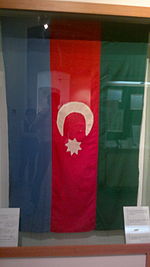

The basic design of today's flag was designed in the spring of 1917 by the Azerbaijani poet Ali Bey Hussein Zade for the Muslim Council in Baku . But at that time the tips of the crescent, in contrast to today's flag, reached into the two outer stripes. After the collapse of the Russian Empire , the independent Democratic Republic of Azerbaijan was proclaimed on March 28, 1918 .
On June 21, 1918, the Azerbaijani parliament adopted a national flag created on the basis of the Ottoman flag , which was intended to express the " Turkish character " of the new republic. This new flag consisted of a red cloth with a white crescent and an eight-pointed star in the middle. The crescent moon symbolized Islam and the eight-pointed star should represent the eight Perso-Arabic letters from which the name Azerbaijan ( Persian آزربيجان, DMG Āzarbāiǧān ) was formed. But on November 9, 1918, parliament approved the introduction of a new flag based on the design presented in 1917. Some variants of this flag already had the crescent and star only in the red stripe. This was either in the middle of the flag or was offset to the leech.
 ? Azerbaijani flag at the time of the Muslim Council, Baku 1917
? Azerbaijani flag at the time of the Muslim Council, Baku 1917
 ? Flag of the Democratic Republic of Azerbaijan from June 21 to November 9, 1918
? Flag of the Democratic Republic of Azerbaijan from June 21 to November 9, 1918
 ? Flag of the Azerbaijan Democratic Republic, November 9, 1918 to 1920
? Flag of the Azerbaijan Democratic Republic, November 9, 1918 to 1920
From April 22nd, the republic was part of the Transcaucasian Federation , which broke up on May 26th. Their flag consisted of three horizontal stripes in yellow-black-red.
The Soviet Commune of Baku was founded on May 8, 1918 . Their flag showed the state name in gold letters on a red background. The commune only existed for a few weeks, but on August 14, 1918 the Central Aspic dictatorship was founded, which was supported by the British . It lasted until September 15th. Their flag showed three horizontal stripes in light blue-red-light blue.
The Turkey occupied the country in September 1918, but withdrew in November back whereupon the British occupied the area. The republic existed until April 1920 when Soviet troops occupied Azerbaijan.
 ? Transcaucasian Federation , April to May 1918
? Transcaucasian Federation , April to May 1918
 ? Baku Soviet Commune , May 1918
? Baku Soviet Commune , May 1918
 ? Central Aspic dictatorship , August to September 1918
? Central Aspic dictatorship , August to September 1918
As part of the young Soviet Union, Azerbaijan carried various flags from 1920. The first flag was a red flag with a yellow crescent moon and a star in the top left corner. Between 1921 and 1922, the Azerbaijani SSR used a red flag with the Cyrillic letters ССРА ("SSRA"). In some versions, the letters were underlaid with a green canton. Between March 12, 1922 and December 5, 1936, Azerbaijan was part of the Transcaucasian SFSR . In 1936 the Azerbaijani SSR received its own flag again, a red flag with the letters AzSSR and a hammer and sickle . From 1939 the Cyrillic lettering АзССР was used.
From October 7, 1952, the Soviet Socialist Republic carried a flag based on the design of the painter K. M. A. Kjazimzade. It was solid red with a narrow, horizontal blue stripe on the lower edge, which stood for the Caspian Sea and for the Turkic people of the Azerbaijanis. Near the flagpole, the flag in the center of the red stripe in gold showed hammer, sickle and five-pointed star. There was no hammer and sickle on the back of the flag.
1: 2 ? Flag of the Azerbaijani SSR, 1920 to 1921


1: 2 ? Flag of the Azerbaijani SSR, 1921 to 1922


1: 2 ? Flag of the Azerbaijani SSR, 1921 to 1922


1: 2 ? Flag of the Transcaucasian SFSR, 1922-1936


1: 2 ? Flag of the Azerbaijani SSR, 1937 to 1939


1: 2 ? Flag of the Azerbaijani SSR, 1939 to 1952


1: 2 ? Flag of the Azerbaijani SSR, 1952 to 1991


Military flags of Azerbaijan
The flag of the Azerbaijan Navy follows Soviet tradition. A white flag with a red crescent moon and star, an anchor and waves at the bottom. However, it is not used as a naval war flag or jack , but only as a ceremonial flag.
 ? Service flag at sea
? Service flag at sea
Political flags
The state flag of Azerbaijan, in a slightly modified form, became the party flag of the successor to the Communist Party and the current ruling party, Yeni Azərbaycan ("New Azerbaijan"). Azerbaijan's oldest party, Müsavat Partiyası , founded in 1911 , originally carried a light blue flag with 45 crescent moons and stars. She now uses a flag with only a large crescent moon and star.
 ? Former flag of the Müsavat Partiyası
? Former flag of the Müsavat Partiyası
Nakhchivan
The Nakhichevan Autonomous Republic had its own flag during the Soviet era. It was a typical Soviet-style flag, red base color, hammer and sickle and the name of the ASSR in yellow. Symbols and lettering were missing on the back. Unofficially, there is now a flag in various variants with three horizontal stripes in blue, red and yellow, a yellow crescent moon and a star.
Nagorno-Karabakh
The Nagorno-Karabakh Republic is a stabilized de facto regime that belongs to Azerbaijan under international law . It uses a variant of the flag of Armenia , which symbolizes the political will to join Nagorno-Karabakh to Armenia.
South Azerbaijan
The South Azerbaijani Awakening Movement (SANAM), a separatist movement in South Azerbaijan , Iran , uses a flag that is derived from the national flag of Azerbaijan.
Trivia
In Baku, on the place of the state flag ( Dövlət Bayrağı Meydanı ) stands the third highest flagpole in the world at 162 m . In 2011 it was replaced as the front runner by a mast in Dushanbe ( Tajikistan ), which in turn was replaced by a mast in Jeddah ( Saudi Arabia ) in 2014 . The Azerbaijani flag is said to be around 2,450 m² (35 × 70 m) and weigh 250 kg.
Individual evidence
- ↑ Azerbaijan celebrates National Flag Day , November 9, 2010 , accessed December 24, 2012
- ↑ Flags of the World : Republic of Azerbaijan, 1918-1920 , accessed December 23, 2012
- ↑ Today.az, October 28, 2008, Highest flag in Azerbaijan to be fastened to a 162 meter high flagpole
